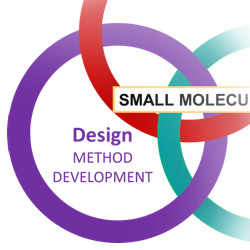
Method development
Gold as a catalytic Lewis Acid
Gold catalysis has bloomed in the past decade. The strong relativistic effects governing gold’s coordination chemistry, and its thus favorable interaction with π-unsaturated system explain its big synthetic potential as a carbophilic Lewis acid. A particularly productive field is the activation of propargyl carboxylates towards 1,2-migration of the acyl group and/or Claisen [3,3]-sigmatropic rearrangements.
Gold-stabilized carbocations: Methodology and Synthetic applications
Our group discovered that propargyl acetates incorporating a cyclopropyl substituent can suffer a gold-catalyzed homologous Rautenstrauch reaction generating either 5- or 6-membered ring systems in a stereocontrolled manner. Upon coordination of gold to the alkyne and 1,3- or 1,2-migration of the acetate moiety, the cyclopropyl ring undergoes a ring-opening process so that a 1,5- or a 1,6-gold dipole is generated, which upon cyclization delivers five- and six membered ring terpenoids, respectively. The stabilization of cationic intermediates is crucial for this reaction to succeed. These dipole intermediates can be better defined as ‘gold-stabilized non-classicalcarbocations’ in which gold is able to stabilize the positive electron density generated upon opening of the three membered rings.We hypothesized that such “non-classical gold-stabilized carbocations” could constitute an efficient platform for the stereocontrolled synthesis of larger ring sizes. An intermolecular version of this methodology has been used in a formal enantioselective synthesis of marine norsesquiterpenoids Frondosins A and B.

Publications:
-
Y. Zou, D. Garayalde, Q. Wang, C. Nevado, A. Goeke
Angew. Chem. Int. Ed. (2008), 47, 10110 -
D. Garayalde, E. Gómez-Bengoa, X. Huang, A. Goeke, C. Nevado
J. Am. Chem. Soc. (2010), 132, 4720 -
D. Garayalde, K. Krüger, C. Nevado
Angew. Chem. Int. Ed. (2011), 50, 911 -
D. Garayalde, C. Nevado
ACS Catal. (2012), 2, 1462
Stereoselective Synthesis of 2,3-Bis-acetoxy-1,3-dienes
Our group has also reported a stereocontrolled synthesis of 2,3-bis(acetoxy)-1,3-dienes by a novel gold-catalyzed tandem 1,2-/1,2-bis(acetoxy) rearrangement. Upon stabilization of the reaction intermediates, the ligand attached to gold controls the stereochemistry of the alkene in the second acetate migration, that is, N-heterocyclic carbenes (NHC) favor cis-alkenes, whereas phosphine ligands selectively afford trans-olefins.
Publications:
-
X. Huang, T. de Haro, C. Nevado
Chem. Eur. J. (2009), 15, 5904 -
T. de Haro, E. Gómez-Bengoa, R. Cribiú, X. Huang, C. Nevado
Chem. Eur. J. (2012), 18, 6811
Gold(I)/Gold(III) Catalytic Cycles
Due to its high electronegativity and ionization potentials, gold has long been considered a redox-stable Lewis acid. The high oxidation potential of the Au(I)/Au(III) pair (Eo = +1.41 V) seemed to preclude an oxidative addition step of gold(I) complexes. However, Au(I)/Au(III) redox catalytic cycles have aroused in recent years and synthetic applications have also been devised. Our group hypothesized that Au(I)/Au(III) turnovers could rely on the use of a strong oxidant to enable the oxidation of the metal followed or preceded by the coordination of an additional organic fragment. Reductive elimination on a highly oxidized intermediate would be responsible for the formation of the new C–C or C–heteroatom bond.
Gold-Catalyzed Ethynylation of Arenes
Using this concept, we aimed to find an alternative method to the well-established Sonogashira cross-coupling reaction that would enable the coupling electron-rich aromatic substrates with electron-deficient alkynes through the direct functionalization of both Csp2–H and Csp–H bonds. We hypothesized that gold(I)-alkynyl species would be formed in situ, in analogy to the copper acetylides found in the Sonogashira reaction. In the presence of a strong oxidant such as iodobenzenediacetate, a gold(III) intermediate would be generated. This highly electrophilic complex could then react in the presence of an electron-rich arene to give an aryl-Au(III)-alkynyl intermediate, which upon reductive elimination would generate the new Csp-Csp2 bond and gold(I) to start a new catalytic cycle.
In support of such mechanism, we have been able to prepare, isolate, and characterize electron-deficient pentafluorophenylgold(III) complexes and have investigated their reactivity toward other nucleophilic aromatic and heteroaromatic counterparts. An oxidative cross-coupling starting from the corresponding gold(I) complexes in presence of hypervalent iodide oxidants was also studied.
Publications:
-
T. de Haro, C. Nevado
J. Am. Chem. Soc. (2010), 132, 1512 -
M. Hofer, C. Nevado
Eur. J. Inorg. Chem. (2012), 9, 1338 -
M. Hofer, C. Nevado
Tetrahedron (2013), 69, 5751
Gold-Catalyzed Difunctionalization of Alkenes
We hypothesized that Au(I)/Au(III) redox catalytic cycles could be employed towards the efficient difunctionalization of non-activated alkenes. In the presence of a catalytic amount of gold(I) and a stoichiometric amount of oxidant, external nucleophiles (water, alcohols, acetonitrile and difluoroiodonium salts) can be incorporated into unactivated olefins yielding the corresponding amino-alcohols, ethers, esters, amides, 2-fluoropiperidines and azepanes in excellent yields and stereoselectivities.
Publications:
-
T. de Haro, C. Nevado
Angew. Chem. Int. Ed. (2011), 50, 906 -
T. de Haro, C. Nevado
Angew. Chem. Int. Ed. (2013), 52, 2469
Methods for efficient C-F bond formation
The efficient introduction of C-F bonds into organic molecules is a major research focus nowadays due to the special properties that F-containing compounds present with respect to their C-H counterparts. Our group has developed one-pot trifluoromethylation/aryl migration/desulfonylation and C(sp2)–N bond formation cascade reactions with conjugated tosyl amides as starting materials. The reaction affords α-aryl-β-trifluoromethyl amides bearing a quaternary stereocenter or trifluoromethylated oxindoles in a regioselective manner. We have also described the first example of a metal-free aryltrifluoromethylation of alkenes. Trifluoromethylated isoquinolinediones and oxindoles can be in excellent yields but also in a highly regioselective fashion.
Publications:
-
W. Kong, M. Casimiro, E. Merino, C. Nevado
J. Am. Chem. Soc. (2013), 135, 14480 -
W. Kong, M. Casimiro, N. Fuentes, E. Merino, C. Nevado
Angew. Chem. Int. Ed. (2013), 52, 13086
We have also devised two gold-catalyzed processes for the efficient formation of C–F bonds. We have used propargyl acetates and alkynes as benchmark substrates, enabling the synthesis of α-fluoroenones,α-fluoroacetals and/or α-fluoro ketones in a single synthetic operation.
Publications:
-
T. de Haro, C. Nevado
Chem. Commun. (2011), 47, 248 -
T. de Haro, C. Nevado
Adv. Synth. Cat. (2010), 352, 2767
